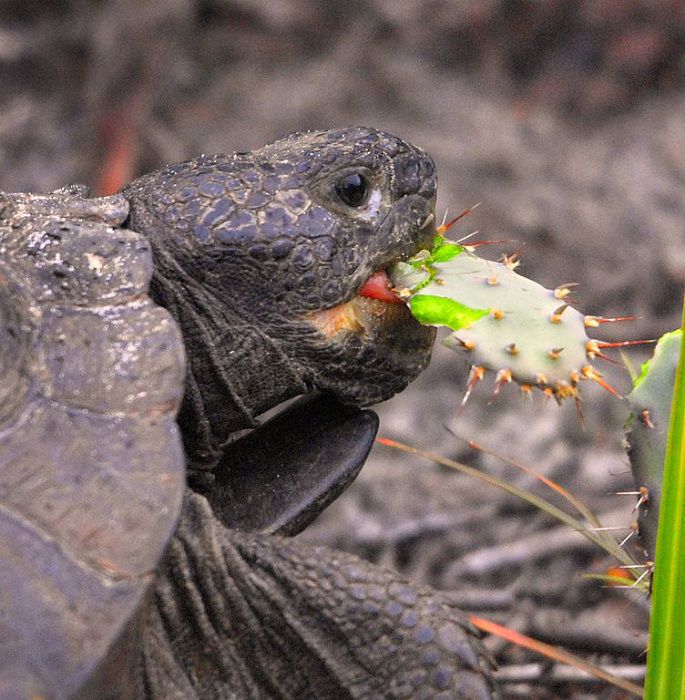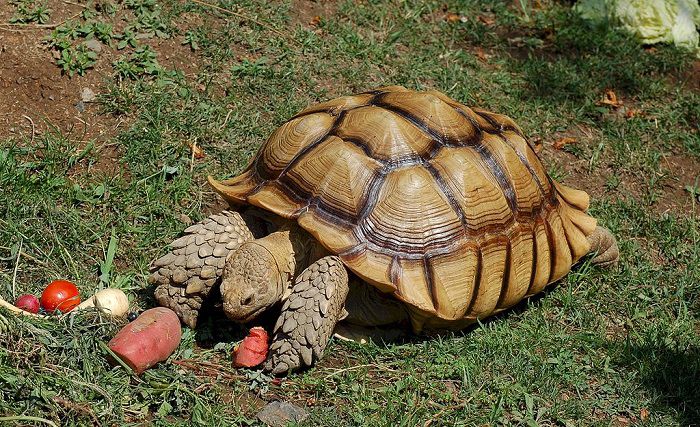Table of Contents
One of the most important questions that any novice pet owner has is what they should be feeding their new pet. Once you find out the type of food the animal in question likes to eat, the next question will be how much the pet should be eating. If you have recently bought a pet tortoise, it is natural to wonder what and how much it should be eating each day. After all, just how much do tortoises eat in a day?
eat in a day?
What Foods Do Tortoises Like to Eat?
You are likely to find commercial food for almost any pet, and it is certainly no different for tortoises. However, before you rush out to buy food that has been mass produced, have a think about what type of food tortoises eat in the wild.
Obviously, the species of tortoise and where it hails from will play a role in the type of food that it eats in its natural environment. It is best, then, to consider the species of tortoise you have before deciding on a food source. Some tortoises prefer to eat plants only while others will eat animal protein as well. Below is a list of some of the popular pet species of tortoises and what they like to eat:
- Hermann’s Tortoise – In the wild, Hermann’s tortoises will mostly eat plant matter, but they have been known to eat meat as well. It is best to supply things such as collard greens and dandelion leaves. Some owners have been known to offer dog food, but I do not recommend this.
- Red-Footed Tortoise – The red-footed tortoise is an omnivore, so it eats both plant and animal matter in its natural habitat. While plants such as hibiscus flowers and dandelions are a great source of food in captivity, you should also try to offer mealworms or specially designed tortoise pellets so that your tortoise will get the fiber it needs.
- Russian Tortoise – In their natural environment, Russian tortoises typically graze on plant stems and grasses. In captivity, these tortoises enjoy eating dandelions and bramble leaves, but you can also offer up baby leaf salad.
- Leopard Tortoise – Grass is the main food source for the leopard tortoise, but they can also have a small amount of fruit as a treat. Clover and dark leafy greens are suitable for this type of tortoise, but you could also supply herbs such as parsley, mint, and coriander as well.
- Sulcata Tortoise – The sulcata tortoise hails from arid, desert areas and likes to eat pant stems and grasses. Pet sulcatas enjoy eating dark leafy greens as well as dandelions and prickly pear cactus. Small amounts of fruit such as melon and apple can also be provided in moderation. Be aware though that too much can lead to problems.
What Your Tortoise Should Not Eat
Although plants and grasses are typically best for tortoises, these reptiles will also eat other foods if available, even if these are not particularly good for them. And while some tortoises do like to eat animal protein, as mentioned above, it is best to avoid any food that contains more than fifteen percent protein. Other foods to avoid include:
- dairy
- bread
- frozen vegetables
- canned vegetables
- celery
- spinach.
Important: If your tortoise is allowed to graze outside, make sure that it cannot eat plants belonging to the same family as the daffodil, ivy, holly, primrose, and azalea as these are all toxic. You should also make sure that there are no toadstools in your lawn.

Should a Tortoise be Fed Every Day?
A healthy, active tortoise will eat every day (unless it is hibernating). How much to feed a tortoise each day is a question many novice tortoise owners ask. There is no definitive answer to this question though because the amount of food a tortoise eats will typically depend on its age and its species.
Baby tortoises will definitely need to eat every day as they are growing, but older tortoises can quite easily skip meals, or even days, without any major issues. What you should be aware of too is that tortoises are fussy when it comes to food. If you have offered up food that they do not particularly like, they will quite happily wait until something preferable comes along.
So while it is not essential for a tortoise to eat every day, it is probably best to supply food each day so that your pet can always have access to food as and when it wants it. As tortoises are natural grazers, as long as there is food available, they will typically eat when they want to.
How Much Food Should You Provide a Tortoise?
If you are wondering how much food a tortoise should eat in a day, it is worth bearing in mind that while tortoises in the wild tend to only eat when hungry, captive tortoises do not seem to have the same regulation when it comes to food. This means there is a risk of overfeeding your pet.
Note: It is best then to remove uneaten food in the evening to reduce the risk of impaction. As a tortoise’s digestive system works more efficiently in warmer temperatures, it is better that they do not eat when it is cooler as it can take longer for the food to work its way through the body.
As a general rule, the amount of food you provide for your tortoise each day should not be larger than the size of their shell.
Will Tortoises Overeat?
As mentioned above, tortoises in captivity do not have the same regulation when it comes to food as those in the wild. As with all captive animals, these reptiles will become accustomed to food being provided for them and they will, with time, just eat whatever is in front of them. This means that they could easily eat too much. The problem with feeding a tortoise too much, especially a young, growing tortoise, is that its body could start to become too large for its shell as it (the body) is growing quicker than the shell (which is effectively not keeping up).
Conclusion
What foods, and how much to feed a pet tortoise, are important questions new owners ask. The type of food will typically depend on the species. How much you provide each day will usually be determined by the age of the reptile. I would recommend that any potential tortoise owner research the species and the type of foods that are safe to eat for the species in question.
Remember, only provide a daily amount of food that is roughly the same size as its shell.
Photo Credits:
- Featured Image (African Spurred Tortoise): Melissa Mitchell
 – CC BY-SA 3.0
– CC BY-SA 3.0 - Gopher Tortoise: Andrea Westmoreland – CC BY-SA 2.0

